|
Copyright © 2006 David Silver.
THE 1908 BELL PANORAMA CAMERA THE ART OF SIMPLICITY IN A RARE AMERICAN PANORAMIC CAMERA! by David Silver 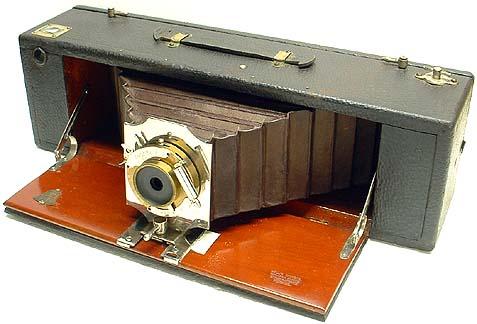 Bell's Straight Working Panoramic Camera of 1908. At the turn of the 20th century, photographers were both blessed and cursed with a number of ingenious solutions to the problem of capturing true panoramic images. The blessing came in the form of innovative cameras whose lenses would pivot and scan the exposure across a broad curved focal plane, or cameras powered by clockwork motors that rotated on a central axis. The curse came in the form of those same cameras often sporting hefty price tags, or relying on confusing and erratic complexity. By 1908 the market was ripe for a camera that simplified the panoramic process while remaining readily accessible and affordable to the general public, and the Bell Panorama Camera arrived just in time to fill that niche. While a number of "pivoting" panoramic cameras, exemplified by Multiscope's Al-Vista and the Panoram Kodaks, and "rotating" cameras, such as Century's and Folmer & Schwing's Cirkut outfits, were establishing their success at the higher end of the photographic market, Isaac A. Bell of Cedar Rapids, Iowa, envisioned a camera based on simpler design principles that would produce an extra wide format without the need for complex internal mechanisms. He recognized that the science of optics had advanced to a point where inexpensive wide-angle lenses were available, although hardly perfect, that at least no longer suffered from extensive and bothersome image distortion. Embracing concepts that had already proven their viability in the amateur camera market, he was awarded US Patent #885,010 on April 21st of 1908 for his own original panoramic camera design, and production started that same year through the newly incorporated Bell Camera Company in Grinnell, Iowa. 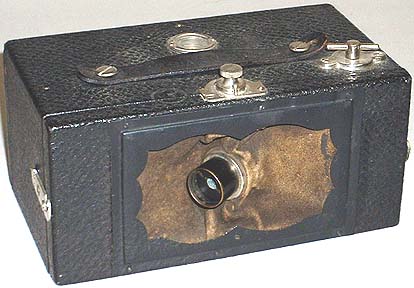 The Baby Al-Vista No. 1 of 1906, a classic "pivoting" or "swinging" lens camera . The first product out of the Bell factory was properly titled Bell's Straight Working Panoramic Camera, although it was more generically known as simply the Bell Panorama camera. The "straight working" designation referred to its unique position as the only camera producing a panoramic image on a straight rather than curved focal plane, and without the need of any complex mechanical manipulations. That innovation alone made the Bell stand out from its competition, but there were several other features that made it even more remarkable. Rather than trying to "reinvent the wheel", Isaac Bell noted the rampaging success of amateur folding bellows cameras, such as the Folding Pocket Kodak series, and further acknowledged the particular popularity of "post card" size pictures made possible by #122 roll film. The foundation of this success was undoubtedly the wildly influential No. 3A Folding Pocket Kodak that introduced #122 in 1903, and then the sudden torrent of clones that followed, most especially in horizontal "landscape" orientation, such as the No. 3A Folding Hawk-Eye and No.9 Folding Ansco. 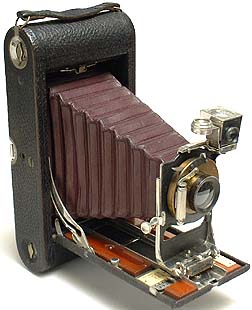 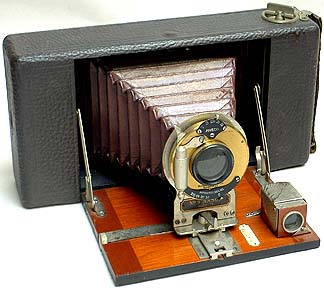 Two classic examples of "post card" format cameras for #122 roll film; the No. 3A Folding Pocket Kodak that introduced #122 in 1903, and the No. 9 Folding Ansco of 1907 that offered horizontal "landscape" orientation. The Bell Panorama camera was a more luxurious expansion on that horizontal theme, featuring a low rectangular wooden body, covered in dark rich leather, with a broad door opening to reveal a bed of nicely polished maple or mahogany, and an unusually expansive maroon red bellows. A waist level reflex viewfinder, with a wide angle of coverage, was installed directly into a front corner of the body for greater stability, more like a large box camera than what was normally seen on a folding model. The working part of the camera was a fancy brass-cased Gundlach Optical Company multi-speed shutter with additional nickel-plated pneumatic piston release for long exposures, and an early Gundlach wide-angle symmetrical lens of 6 3/4 inch focal length and f11 maximum aperture. With the glossy nickel front standard pulled out into shooting position and the bellows fully extended, the overall impression was that of a typical horizontal format folding roll film camera, perhaps "bulked up" a bit on steroids, but certainly recognizable and familiar to the picture taking public. 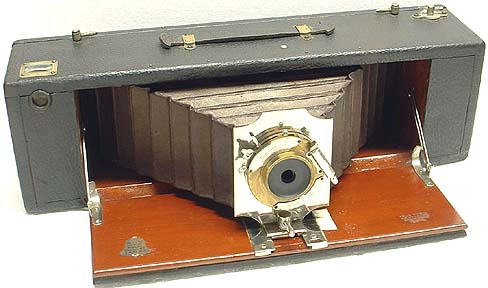 Another view of the rare and beautiful 1908 Bell Panorama Camera. The next feature of the Bell that more firmly established its appeal and practicality was the choice of medium. Once again, rather than invent something new or specific to the camera, Isaac Bell modeled his design to accept #122 roll film, which by that time was common and available throughout the world. The panoramic format was a generous 3 1/4 x 11 inches, but here is where the real genius of the Bell patent came into play. Realizing that #122 film had become such a genuine favorite in the amateur market, Isaac Bell sought to take advantage of that popularity by providing the capability for a second format within his camera. The mechanism is beguilingly simple, yet undeniably effective. There are two small levers on top of the camera body, positioned at opposite corners towards the back, which rotate about 45 degrees. Each lever manipulates an internal fabric panel that can be pivoted forward against the inside of the bellows, opening up the focal plane for full panoramic exposures, or pivoted back towards the film, thus masking a portion of the film plane and creating the traditional 3 1/4 x 5 1/2 inch "post card" size frame! Dual ruby windows on the removable back loading panel allowed the photographer to accurately follow the progress of a roll of film through the camera by keeping track of the exposure numbers, whether shooting the full panoramic format or the standard "post card" size. Furthermore, the format could be changed at any time, so that any combination of panoramic and standard pictures could be taken on a single roll of film. 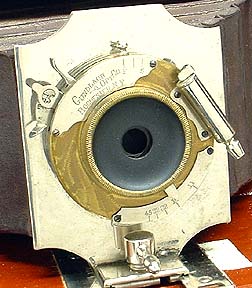 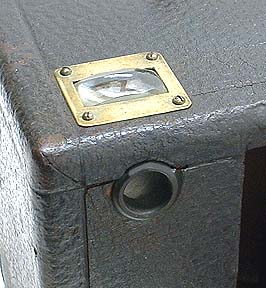 Details of the Bell's fancy shutter (left) and unusual wide body-mounted viewfinder (right). The Bell Panorama camera was as simple in function as it was in design. While the optical engineering of the lens theoretically provided a maximum aperture of f8, the shutter's diaphragm control is only marked to f11 as that is the largest opening at which an image will fully expose across the entire standard 3 1/4 x 5 1/2 inch frame. Even at that setting, there was a noticeable drop in exposure quality in the extreme corners, so the instructions strongly recommended choosing an aperture of f16 or smaller for safe coverage. In panoramic mode, the camera always had to be mounted on a tripod because the lens necessitated a setting of f45 for complete coverage across the wider image area, and this then required exposure times of 1/2 second or more. By today's standards, this might seem like an annoying compromise for the inadequacies of the optical design, but remember that all other panoramic cameras of that period also required a tripod, and furthermore demanded absolutely level positioning to avoid disorienting curved or tilted horizon lines in the final image, so by comparison the Bell was refreshingly straight forward and simple in application. Plus, with such small apertures, the resulting increased depth of field provided a sharp image at a single convenient fixed focus. As an added bonus, there was a second tripod socket on the side of the camera, so the whole affair could be easily mounted on its edge to take tall vertical "skyscraper" photographs as well! 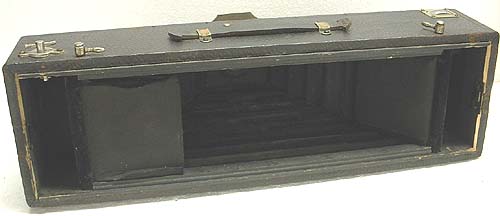 The inside workings of the 1908 Bell, showing the internal baffles in closed and open positions. Originally marketed through the American Northern Photo Supply Company, the Bell Panorama camera suffered through several years of unwarranted anonymity due to poor promotion and advertising. Researching today through period catalogs and photographic company brochures, it's a small miracle the camera sold at all. Considering its superb design, functional simplicity, and overall bulletproof concept, it was strangely conspicuous by its absence in the popular retail literature. On the other hand, at the same time it was highly praised by industrial reviews! The result is that the original Bell's Straight Working Panoramic Camera remains a notably rare and extremely valuable item for the savvy collector, and one of the unsung heroes in the evolution and advancement of camera technology. 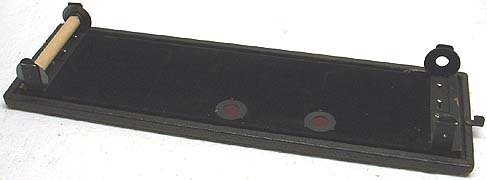 The removable back panel of the 1908 Bell also held the film spools. Despite such poor sales, Isaac Bell never lost faith in the concept and continued to improve his product. After minor changes, mostly concerning optics and exposure control through a switch to Wollensak components, he decided to embrace certain cost cutting measures in a carefully revised approach to his camera. He received US Patent #999,949 on August 8th of 1911 for the updated design, and in 1912 he authorized manufacture of the new Bell Panorama and Panel Camera. While ostensibly the exact same concept in overall function and application as the earlier Bell's Straight Working Panoramic Camera, the improved Bell Panorama and Panel Camera used less expensive materials, which in turn lessened its aesthetic appeal, but redistributed the cost in superior lenses and shutters. Genuine plush leather covering gave way to generic imitation leatherette. The beautiful polished wood interior was painted over. And that gorgeous expanse of maroon red bellows was rendered basic black. However, in virtually every other way, it was still the same simple and effective panoramic camera Isaac Bell had intended, and it now offered a bit more functional bang for the buck. 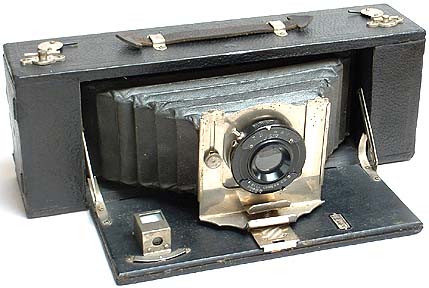 The improved Bell Panorama and Panel Camera of 1912. The new Bell Panorama Camera featured improved levers for the internal panels that would not twist or turn beyond their intended range. There was an expanded focusing scale and a more substantial front standard assembly. And the fixed body viewfinder was replaced with a pivoting reflex viewfinder on the bed that would lock straight ahead for postcard shots or "scan" back and forth for panoramic framing. Most importantly, the camera now came with several choices of more advanced Wollensak multispeed shutters, such as the Regno and Victo, and the accompanying Wollensak lenses were incrementally sharper than what preceded them. The basic Wollensak wide-angle symmetrical, with a maximum allowable diaphragm setting of f12, still suffered from slightly uneven exposure in the image corners if the aperture was too large, but a later more expensive option for the more demanding photographer was the outstanding Wollensak Velostigmat Wide Angle Series III. It boasted truly balanced exposure across the entire panoramic frame at its maximum aperture of f9.5, and that in turn translated to much faster and practical exposure times. Towards the end of 1912 Isaac Bell made one final "improvement" when he abandoned his relationship with the American Northern Photo Supply Company and their questionable practices, and agreed to a nonexclusive distribution contract with Sears Roebuck. The camera finally found a regular market there, and sold modestly for another five years. In fact, the demand was just enough that in 1916 Bell introduced a smaller model designated the No. 10 Bell Panorama and Panel Camera. It was a veritable clone of the larger model in every way, except that it used readily available #118 roll film to make standard exposures 3 1/4 x 4 1/4 inches or panoramic exposures 3 1/4 x 8 1/2 inches. Unfortunately, by 1918 the interest in Bell's concept had waned considerably in the face of sudden market changes and newer more enticing technology, and his panoramic cameras were no longer featured in any further catalogs or advertisements. In retrospect, the fascination for panoramic images has come and gone through several different periods in the history of photography, but from 1908 to 1918 the Bell Panorama cameras represented that rare instance where a practical advancement was made through the intelligent incorporation of other already established technological concepts. In this case the result was a combined standard and specialty camera that bridged a gap in a rapidly changing market, and provided professional quality potential at a fair price to mostly amateur consumers. Today the Bell Panorama cameras, and most especially the rare original model of 1908, remain valuable and desirable artifacts for any motivated collector of great photographic antiquities, and classic examples of how a well designed whole can outweigh the sum of its many parts. 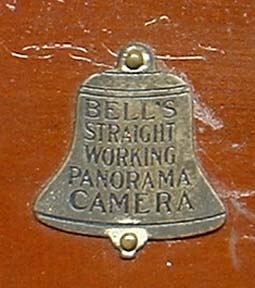 The distinctive label on the original 1908 Bell Panorama camera. Copyright © 2006 David Silver. All rights reserved. This article first appeared, in slightly edited form, in the February 2006 (issue #162) Camera Shopper magazine. If you'd like to reprint the article, acquire secondary rights, or inquire on the availability of new articles, please feel free to contact the author at silver@well.com, thank you! BACK to the International Photographic Historical Organization article page! GO TO the International Photographic Historical Organization home page! CONTACT the author, David Silver, for more information! |